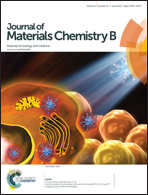Fabrication of polymer brush surfaces with highly-ordered perfluoroalkyl side groups at the brush end and their antibiofouling properties†
Abstract
Acrylate block polymer brushes (Au-PMMA65-b-PODMAy-ec-FMA2) with two 2-perfluorooctylethyl methacrylate units at the brush end were successfully prepared on an Au substrate using a “grafting to” method. Characterization by XPS, contact angle measurement, ellipsometry and nanomechanical measurement showed that a well-ordered and perpendicularly oriented structure of the perfluoroalkyl side chains on the brush surface was enhanced with an increasing degree of polymerization (y) of poly (n-octadecyl methacrylate), and a crystalline structure of perfluoroalkyl side chains formed when y was equal to 24. Protein adsorption studies indicated that the adsorbed mass of fibrinogen decreased with an increasing order of the structure of the perfluoroalkyl side chains at the brush end. When the perfluoroalkyl group on the brush surface formed a crystal structure, there was only trace fibrinogen adsorption on the brush surface. This work demonstrates that the protein-resistant performance was enhanced greatly by constructing polymer brush surfaces with well-ordered and perpendicularly oriented structures of the perfluoroalkyl side chains.


 Please wait while we load your content...
Please wait while we load your content...